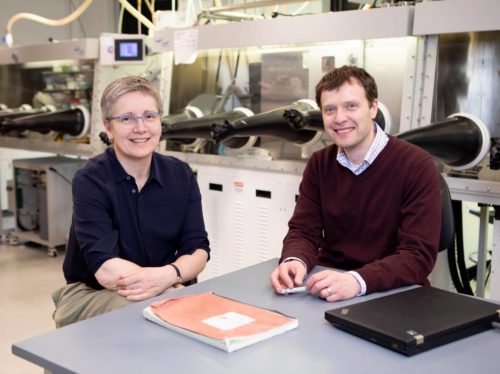By Catherine Zandonella, Office of the Dean for Research
Three research endeavors at Princeton University aimed at addressing fundamental challenges in health, information technology, and water conservation have been selected for funding through the Eric and Wendy Schmidt Transformative Technology Fund. The winning proposals were selected by a committee of peers. Two of the three winning technologies will help to address energy and environmental challenges.
The funding will support work on a new type of laser that enables brighter screen displays and requires less energy to build, and a novel method for harvesting water from air that could transform the habitability and productivity of arid regions.
The goal of the fund is to enable researchers to make leaps rather than incremental advances in the natural sciences and engineering. The fund focuses on projects that lead either to the invention of a disruptive new technology that can have a major impact on a field of research, or on the development of equipment or an enabling technology that will transform research in a field.
Eric Schmidt, former CEO of Google, and his wife, Wendy, a businesswoman and philanthropist, created the fund in 2009. Schmidt earned his bachelor’s degree in electrical engineering from Princeton in 1976 and served as a Princeton trustee from 2004 to 2008.
“These projects have the potential to make revolutionary advances through new tools or technologies that transform how researchers pursue answers to today’s challenges,” said Dean for Research Pablo Debenedetti, the Class of 1950 Professor in Engineering and Applied Science, and a professor of chemical and biological engineering. “The projects selected for funding this year are emblematic of Princeton’s dedication to innovative research that leads eventually to benefits for society.”
The group photos were taken before social distancing protocols were implemented to limit the spread of the coronavirus.

Building a better laser for optical communications and displays
The project, led by Claire Gmachl, the Eugene Higgins Professor of Electrical Engineering, and Barry Rand, associate professor of electrical engineering and the Andlinger Center for Energy and the Environment, aims to revolutionize the use of light as a means of transmitting information and powering display technologies by building a new type of laser that is small, bright, and capable of producing coherent light in a variety of colors. The lasers could find use in devices such as watch and phone displays, autonomous vehicle sensors, “internet of things” devices, light-driven data transmission (LiFi), along with other applications requiring light transmission and detection. The result would be the world’s first electrically driven laser from materials known as metal halide perovskites. These materials can be sprayed like ink onto virtually any surface, making them relatively easy to make at a low cost. The ease of manufacture also comes with energy savings because the process does not rely on the same energy-intensive process of making and working with crystalline materials used in current LEDs. The two researchers recently published a paper on advances in stabilizing this LED technology.
Solving water insecurity by extracting water from air
The project focuses on providing technological solutions to water insecurity, a major threat to populations worldwide. The team combines the expertise of Forrest Meggers, assistant professor of architecture and the Andlinger Center for Energy and the Environment; Sujit Datta, assistant professor of chemical and biological engineering; Sankaran Sundaresan, the Norman John Sollenberger Professor in Engineering and professor of chemical and biological engineering; and visiting collaborator Marco Simonetti, associate professor in thermodynamics and heat transfer at Politecnico di Torino. The researchers will develop a new technology for condensing water from air, which could dramatically expand areas for cultivation and habitation. The proposed method will extract water using 30 times less energy than existing water-harvesting systems. The approach takes advantage of new materials that absorb and release water depending on temperature to collect water both during the day and at night. The project also received E-ffiliates funding earlier this year.
Molly A. Seltzer edited this article for the Andlinger Center’s website.
See full article here: https://www.princeton.edu/news/2020/05/11/three-innovative-projects-selected-receive-funding-schmidt-transformative